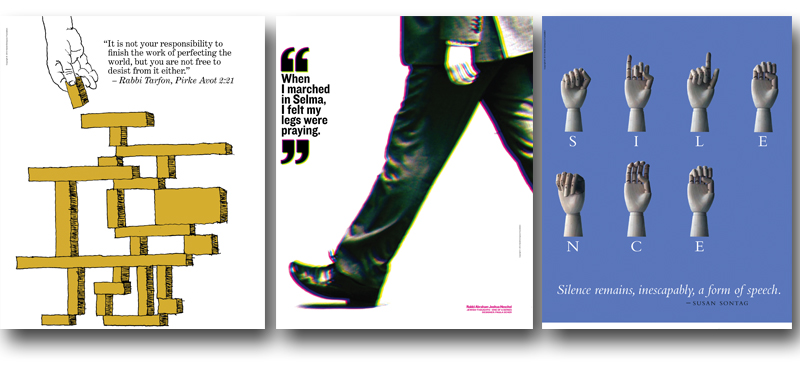
Here's a challenge: Let's say you had $1.1 million to give away on a program to inspire people working in Jewish organizations as well as the people who find themselves in their public spaces.
What would you do? Hand out baseball cards with the pictures of famous rabbis and leaders? Produce mix tapes of Israeli rap music?
Philanthropist Harold Grinspoon had a different idea, and the result can be seen in an exhibition at the Skirball Cultural Center of 18 posters commissioned to marry the work of great Jewish graphic designers and artists with inspirational Jewish quotes. Called "Voices & Visions," the display is on view through March 17.
The featured quotes range from Martin Buber ("All journeys have secret destinations of which the traveler is unaware") to the Baal Shem Tov ("From every human being there rises a light"). There are rabbis galore: Hillel, Tarfon, Akiva, Heschel as well as authors such as Blu Greenberg and Susan Sontag.
My personal favorite is designed by Paula Scher. All it shows is a person purposefully walking, wearing a suit, depicted in profile from the waist down, with a quote from Rabbi Abraham Joshua Heschel: "When I marched in Selma, I felt my legs were praying."
There is also a series of accompanying texts -- viewable online at skirball.org -- that are produced by writers as diverse as Erica Brown, Rabbi Daniel Gordis, Rabbi Joseph Telushkin and Rabbi Irving Greenberg.
Grinspoon's eponymous foundation, located in western Massachusetts, recently distributed 6,000 complete sets of the posters to Jewish institutions, PJ Library partners and cultural organizations. They are available for free through the program (voices-visions.org), at least for the first set, and there is a limited, signed edition that either will be given, offered for sale or offered at auction.
The concept behind the project is the famous ad campaign by the Container Corp. of America, called "Great Ideas of Western Man," which ran between 1950 and 1975. Its posters by accomplished artists and designers such as Fernand Léger, Milton Glaser and Saul Bass, featured quotes from such inspirational thinkers as John Stuart Mill, Woodrow Wilson and Abraham Lincoln.
Grinspoon wondered if the same could be done pairing great Jewish quotes with Jewish graphic designers and artists. He discussed the idea with his friend Nancy Berman, a former curator of the Jewish Museum in New York and the founding director emerita of the Skirball. Berman knew Louis Danziger, who had worked on the original Container Corp. campaign. He, in turn, suggested Arnold Schwartzman as artistic director, at which point the project began to take shape.
Schwartzman was born in London, and, as a child during World War II, his home was destroyed on the first day of the Blitz -- his family had to be dug out of the rubble. Later, his family ran a kosher hotel in the seaside resort of Margate. He attended art school and then went into military service and was posted to the Korean DMZ, where his chaplain was Chaim Potok, the author and rabbi. Upon his return, he began a career as a graphic designer, first in television and then in advertising.
Schwartzman, who moved to Los Angeles in 1978, has brought his talent to everything from the London Times to Coca-Cola commercials to the 1984 Olympic Games, where he was design director. He won an Oscar for best documentary feature for 1981's "Genocide," has consulted on design to the Academy Awards since 1996 and has produced some 10 books, numerous films and too many ads to tally. In 2002, Queen Elizabeth appointed him Officer of the Most Excellent Order of the British Empire.
Schwartzman has been a longtime member of the prestigious Alliance Graphique Internationale, an organization of the world's greatest graphic designers, and the friendships he developed there informed the all-star list of graphic designers and artists he assembled for "Voices & Visions": Glaser and George Tscherny (both of whom worked on the original Container Corp. campaign), Art Paul (Playboy's founding art director, who came up with the bunny logo), Hungarian-born Israeli design icon Dan Reisinger, R. O. Blechman (known widely for his New Yorker cartoons), Israeli master designer Yarom Vardimon and many others, including Schwartzman himself.
All are Jewish, for which Schwartzman has no explanation other than the pattern of Jews entering professions for which there was no bar to entry; those raised in religious homes who rebelled by finding a vocation making graven images; and a realization that the grandchildren and great-grandchildren of peddlers, once ensconced in advertising and "brand identity," remained good salesmen. The styles are eclectic, from typography-dominated to visual symbols, from the fine art to the abstractly commercial, some in which Jewish references exist subtly and others more obviously.
"Voices & Visions" was supposed to take four months to put together; instead, it took 18 months. Madeline Calabrese, the program director, explained that a "quote team" was created that not only researched and found potential quotes to be used, but also cleared them, when necessary, for copyright purposes. This took some time.
The purpose of the posters, Calabrese said, is to beautify space in Jewish public institutions as well as render old quotes anew, to "let the artist develop a first take" and trust that conversations will ensue.
The notion that a poster can change a mind, brighten a day or start a conversation seems at first far-fetched. But as people read less, the way they connect to thoughts and information is increasingly graphic and design-driven. (There's a reason Apple Inc. is worth as much as it is.)
At the Skirball, there is a companion exhibit, "Decades of Dissent," which features posters that effectively politicized the world. Meanwhile, at the Hammer Museum, there is an exhibit, "Graphic Design: Now in Production," on logo and brand identity design as well as book design and infographics.
(In a separate contest, the "Voices & Visions" program, in conjunction with PJ Library, invited children ages 7-12 to create their own posters expressing their ideas about tikkkun olam, healing the world.)
All of which reminds us that although a picture may be worth a thousand words, great design helps us see those words in new ways and find new meaning in sayings that have themselves stood the test of time.
